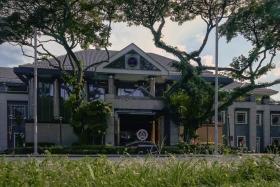Merlion and Changi Airport Control Tower emerge as top heritage sites
Merlion is next 'most important' to 1,500 respondents
Changi Airport's control tower and the Merlion led a list of 53 buildings, sites and structures in a study on perceptions of Singapore's built heritage.
The iconic tower came in first, with the half-lion half-fish national mascot in second place in an Institute of Policy Studies (IPS) survey of 1,500 people aged 18 to 70 who ranked these two as the "most important to them".
The Singapore Science Centre and the Botanic Gardens - a Unesco World Heritage Site - were also ranked highly.
When it came to other landmarks, the old and young were split in their opinions.
For instance, Bukit Brown Cemetery loomed larger in the minds of the youngest group of respondents, aged 18 to 28. The researchers said this could be due to the ground-up social media movements calling for its conservation.
Those aged 49 to 70, who perceived colonial buildings such as the former Supreme Court as important, as well as those who liked the appearance of structures such as the airport control tower, the Benjamin Sheares Bridge, Clifford Pier, and Tanjong Pagar Railway Station, were more likely to have a strong sense of national identity.
This link was not as apparent among younger respondents.
The two-year study, supported by the National Heritage Board's heritage research grant, is the first of its kind. It sought to establish a framework as to how Singaporeans appraise the country's built heritage.
IPS senior research fellow Natalie Pang said the study primarily revealed the diversity in public perceptions of heritage.
The research work, which was centred on built landmarks that are at least 30 years old, also found that sites where public access is limited were ranked more lowly by respondents. These included Pearl Bank Apartments, the NUS Baba House, Kallang Airport and the Bukit Timah Railway Station.
On the popularity of the Merlion and the airport control tower, Dr Pang noted that these two have, over time, become iconic symbols associated with the country.
Post-1965 structures such as Pearl Bank Apartments, Golden Mile Complex, People's Park Complex, and the now demolished Rochor Centre, received much less love from respondents who found them relatively unappealing.
Even though respondents aged 29 to 70 ranked People's Park Complex highly in terms of their awareness, knowledge and memories of the structure, having grown up shopping there, they did not consider it much more important or aesthetically appealing than younger respondents.
Dr Pang said this shows a disconnect between architects' visions and users' experiences.
She said: "This translates into the need to educate the public on modernist buildings, as well as to ensure that impact assessments include criteria that takes into account the importance of evaluating post-independence buildings as markers of modern Singaporean architecture."
Dr Pang added that more effort should be made to consider the everyday meanings associated with sites in planning and heritage conservation decisions.
She said: "One of the key takeaways is that heritage sites contain diverse connotations across social groups. We should not be using a single, monolithic approach to evaluate all of Singapore's heritage sites."
The team believes the findings can help heritage bodies adjust promotional programmes and policies.
Get The New Paper on your phone with the free TNP app. Download from the Apple App Store or Google Play Store now



